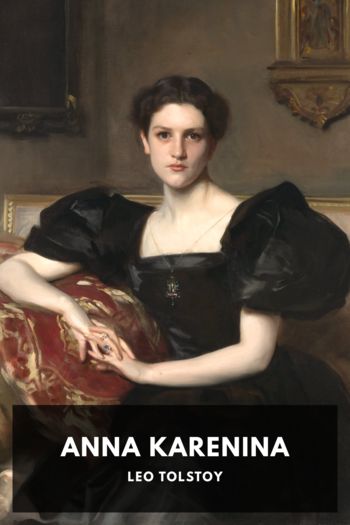What Is Art? Leo Tolstoy (good books to read for 12 year olds TXT) 📖

- Author: Leo Tolstoy
Book online «What Is Art? Leo Tolstoy (good books to read for 12 year olds TXT) 📖». Author Leo Tolstoy
So that the majority of the highest classes of that age, even the popes and the ecclesiastics, really believed in nothing at all. In the Church doctrine these people did not believe, for they saw its insolvency; but neither could they follow Francis of Assisi, Keltchitsky,62 and most of the heretics, in acknowledging the moral, social teaching of Christ, for that teaching undermined their social position. And so these people remained without any religious view of life. And, having none, they could have no standard wherewith to estimate what was good and what was bad art but that of personal enjoyment. And, having acknowledged their criterion of what was good to be pleasure, i.e., beauty, these people of the upper classes of European society went back in their comprehension of art to the gross conception of the primitive Greeks which Plato had already condemned. And conformably to this understanding of life a theory of art was formulated.
VIIFrom the time that people of the upper classes lost faith in Church Christianity, beauty (i.e. the pleasure received from art) became their standard of good and bad art. And, in accordance with that view, an aesthetic theory naturally sprang up among those upper classes justifying such a conception—a theory according to which the aim of art is to exhibit beauty. The partisans of this aesthetic theory, in confirmation of its truth, affirmed that it was no invention of their own, but that it existed in the nature of things, and was recognised even by the ancient Greeks. But this assertion was quite arbitrary, and has no foundation other than the fact that among the ancient Greeks, in consequence of the low grade of their moral ideal (as compared with the Christian), their conception of the good, τὸ ἀγαθόν, was not yet sharply divided from their conception of the beautiful, τὸ καλόν.
That highest perfection of goodness (not only not identical with beauty, but, for the most part, contrasting with it) which was discerned by the Jews even in the times of Isaiah, and fully expressed by Christianity, was quite unknown to the Greeks. They supposed that the beautiful must necessarily also be the good. It is true that their foremost thinkers—Socrates, Plato, Aristotle—felt that goodness may happen not to coincide with beauty. Socrates expressly subordinated beauty to goodness; Plato, to unite the two conceptions, spoke of spiritual beauty; while Aristotle demanded from art that it should have a moral influence on people (κάθαρσις). But, notwithstanding all this, they could not quite dismiss the notion that beauty and goodness coincide.
And consequently, in the language of that period, a compound word (καλο-κἀγαθία, beauty-goodness), came into use to express that notion.
Evidently the Greek sages began to draw near to that perception of goodness which is expressed in Buddhism and in Christianity, and they got entangled in defining the relation between goodness and beauty. Plato’s reasonings about beauty and goodness are full of contradictions. And it was just this confusion of ideas that those Europeans of a later age, who had lost all faith, tried to elevate into a law. They tried to prove that this union of beauty and goodness is inherent in the very essence of things; that beauty and goodness must coincide; and that the word and conception καλο-κἀγαθία (which had a meaning for Greeks but has none at all for Christians) represents the highest ideal of humanity. On this misunderstanding the new science of aesthetics was built up. And, to justify its existence, the teachings of the ancients on art were so twisted as to make it appear that this invented science of aesthetics had existed among the Greeks.
In reality, the reasoning of the ancients on art was quite unlike ours. As Benard, in his book on the aesthetics of Aristotle, quite justly remarks: “Pour qui veut y regarder de près, la théorie du beau et celle de l’art sont tout à fait séparées dans Aristote, comme elles le sont dans Platon et chez tous leurs successeurs” (L’esthétique d’Aristote et de ses successeurs, Paris, 1889, p. 28).63 And indeed the reasoning of the ancients on art not only does not confirm our science of aesthetics, but rather contradicts its doctrine of beauty. But nevertheless all the aesthetic guides, from Schasler to Knight, declare that the science of the beautiful—aesthetic science—was commenced by the ancients, by Socrates, Plato, Aristotle; and was continued, they say, partially by the Epicureans and Stoics: by Seneca and Plutarch, down to Plotinus. But it is supposed that this science, by some unfortunate accident, suddenly vanished in the fourth century, and stayed away for about 1,500 years, and only after these 1,500 years had passed did it revive in Germany, AD 1750, in Baumgarten’s doctrine.
After Plotinus, says Schasler, fifteen centuries passed away during which there was not the slightest scientific interest felt for the world of beauty and art. These one and a half thousand years, says he, have been lost to aesthetics and have contributed nothing towards the erection of the learned edifice of this science.64
In reality nothing of the kind happened. The science of aesthetics, the science of the beautiful, neither did nor could vanish because it never existed. Simply, the Greeks (just like everybody else, always and everywhere) considered art (like everything else) good only when it served goodness (as they understood goodness), and bad when it was in opposition to that goodness. And the Greeks themselves were so little developed morally, that goodness and beauty seemed to them to coincide. On that obsolete Greek view of life





Comments (0)